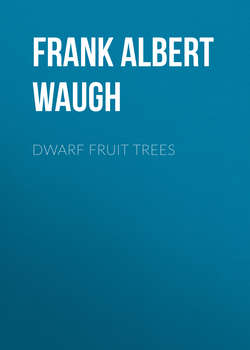Читать книгу Dwarf Fruit Trees - Frank Albert Waugh - Страница 3
II
ADVANTAGES AND DISADVANTAGES
ОглавлениеIt is a good prejudice which expects every man who writes anything to be enthusiastic over his subject. Such enthusiasm doubtless leads a writer many times to over-state his case, and to claim more than the calm judgment of the multitude will ratify. And on the other hand, readers usually tacitly discount the statements of any man who writes about any matter in which he is plainly interested. The present writer knows that he is also under the ban, and that the reader firmly expects him to claim more for dwarf fruit trees than their merits will fairly warrant. This expectation the writer hopes to disappoint. It will be enough to set down here the obvious advantages and disadvantages which the horticulturist will meet in handling dwarf fruit trees. These statements are mostly of matters of common experience and they need no coloring to make them serve their present purpose.
We may fairly set down the following good points standing more or less generally to the credit of dwarf fruit trees:
1. Early bearing.—This is a sufficiently obvious advantage. The Alexander apple will bear the second year after planting when grown as a dwarf, while it requires six to ten years to come into bearing as a standard. This habit of early bearing proves valuable in many ways. It encourages men to plant trees. The disinclination of old men to plant trees rests upon the slenderness of the chance that they will ever gather of the fruit. But a man may plant dwarf trees whenever his expectation of life is two years or more. Such trees would serve octogenarians, consumptives and those sentenced to be hanged for murder.
FIG. 4—PEAR TREE, TRAINED AS AN ESPALIER
Early bearing—to return to the subject—makes dwarf trees valuable to that large and unfortunately growing class of citizens who rent the premises where they live. They do not expect to stay more than five or six years in any one place. In that length of time ordinary trees would not begin to yield any fruit. But with dwarf trees there is excellent probability of seeing something ripen. Then again early bearing is a great advantage when one is testing new or old varieties. It is a great advantage when a commercial orchard is designed and when dwarf trees are used for fillers as explained below.
2. Small size.—The very smallness of the dwarf trees has many advantages in it. The trees are easier to reach and to care for. They are easier to prune and to spray. This facility in spraying is what has chiefly recommended smaller fruit trees to commercial fruit growers in recent years. Particularly in those places where the San José scale is a perennial problem a very large tree becomes an impossibility, and the smaller the trees can be the better it suits.
The small size of dwarf trees permits the planting of larger numbers on a given area. This is specially worth while to the amateur who has a small garden where only three or four standard trees could grow, but where he can comfortably handle forty or fifty dwarfs. Yet it is also worth the consideration of the commercial fruit grower who is trying to earn a profit on expensive land. If he can increase the number of bearing trees on each acre, especially during the early years of establishing his orchard, it almost certainly means increased income.
FIG. 5—BUSH APPLE TREE, THREE YEARS PLANTED
3. High quality.—It is not perfectly certain that every kind of fruit can be produced in higher quality on dwarf trees than on standards, but such is the general rule. This is notably true of certain pears, as Buerré Giffard and Doyenne du Comice, and it is generally the case with all apples that can be successfully grown on Paradise roots. One can secure size, color, flavor and finish on an Alexander or a Ribston Pippin, for example, which can never be secured on a standard tree. One who has not seen this thing done will hardly understand it; those who have will not need more argument. Such plums as we have fruited on dwarf trees have shown similar improvement in quality, being always distinctly superior to the same varieties grown on standard trees. The significance of these facts will appear at once to any one familiar with the course of the fruit markets in America. There are greater rewards awaiting the fruit grower who can produce fruit of superior quality than the one who succeeds merely in increasing the quantity of his output.
